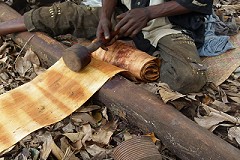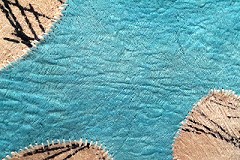Bark Cloth
A unique cloth from Southern Uganda
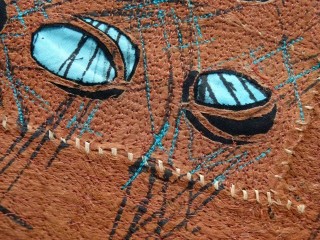 Omweso with Seeds
Omweso with Seeds
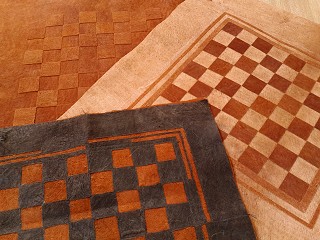 Bark cloth designs
Bark cloth designs
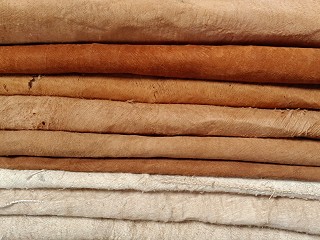 The variety of bark cloth tones and colours
The variety of bark cloth tones and colours
I first discovered bark cloth when visiting Kisaabwa in southern Uganda and have incorporated it into much of my textile work in recent years.
I have worked on several collaborative projects: one with Janet Middleton a professional shoemaker. Friends and colleagues from the textile world purchased a piece of bark cloth which they decorated, sent to Janet, who made them into beautiful shoes, which were exhibited in London and Birmingham. Another project was with Jose Hendo an Ugandan-born eco-sustainable fashion designer, who utilises bark cloth in her garments. We presented work at the Knitting and Stitching show in London, Harrogate and Dublin, in an exhibition which reflected the heritage, the significance and the importance of bark cloth. This exhibition also revealed the passion each of the artists share for bark cloth, the environment and wider global challenges. Bark cloth continues to see a revival by artists in Uganda.
Bark Cloth is probably one of the world's oldest non-woven fabrics and comes from the Mutuba tree (Ficus Natalensis) from the Buganda Kingdom in Southern Uganda, as well as from other parts of the world. Baganda craftsmen have been manufacturing bark cloth for the royal family for centuries and it is still worn for ritual and healing ceremonies, for cultural events and funerals and by healers who would have many bark cloth robes within their shrines each of which represented a different god. When calling up a specific god they would put on the corresponding robe. Traditionally it would have been worn as a toga by both men and women, with the women also wearing a sash.
So what is Bark Cloth?
It is a 100% organic fibre and can be described as an organic 'living' cloth which, in the history of textiles is unquestionably the most ancient cloth and the first non-woven textile. Being bio-degradable and manufactured with no added chemicals or textile agents, gives it added attraction. Bark cloth was discovered during the reign of Ssekabaka Kimera, who ruled from 1217 to 1247 and it still remains steeped in mysterious cultural heritage.
Sadly the demonisation of bark cloth by Christianity and Islam and the introduction of other fabrics by Arab traders and colonialists caused the bark cloth trade to deteriorate, and so was the production. The Mutuba trees continued to serve the agro-purpose and some bark cloth was produced for particular Buganda cultural rituals.
